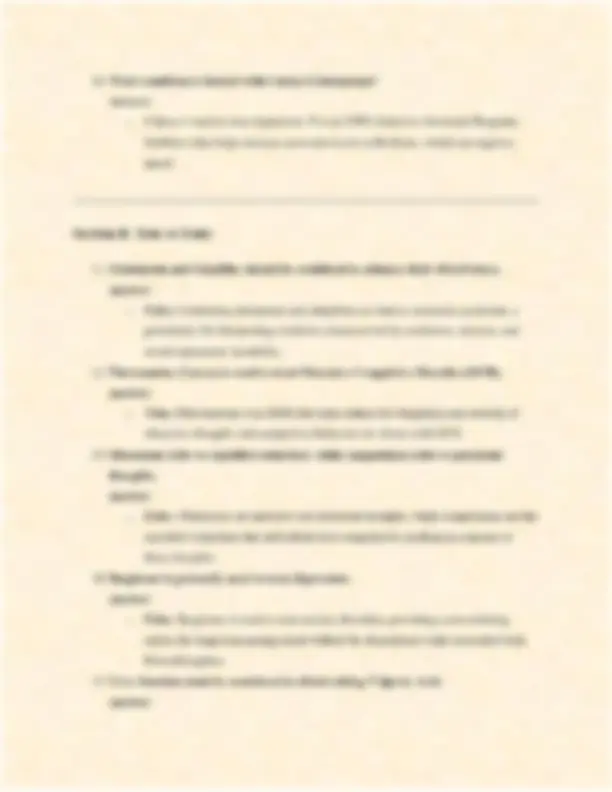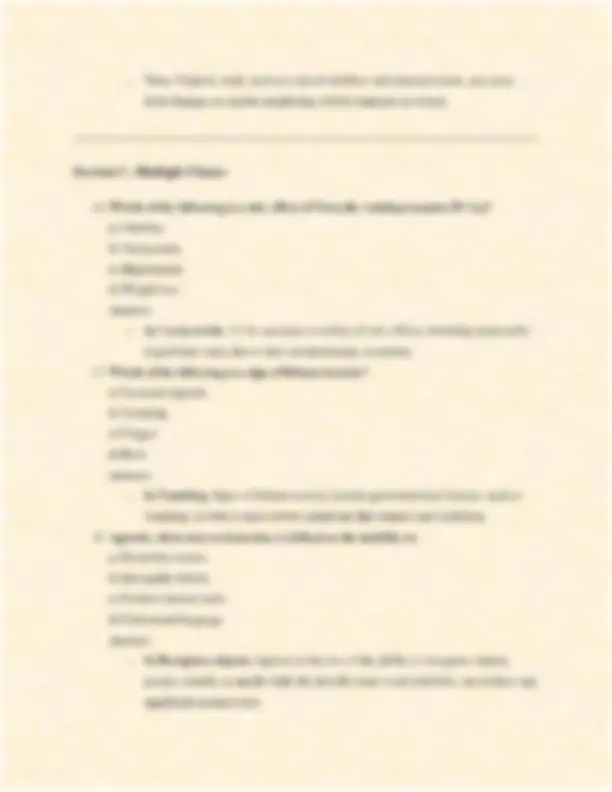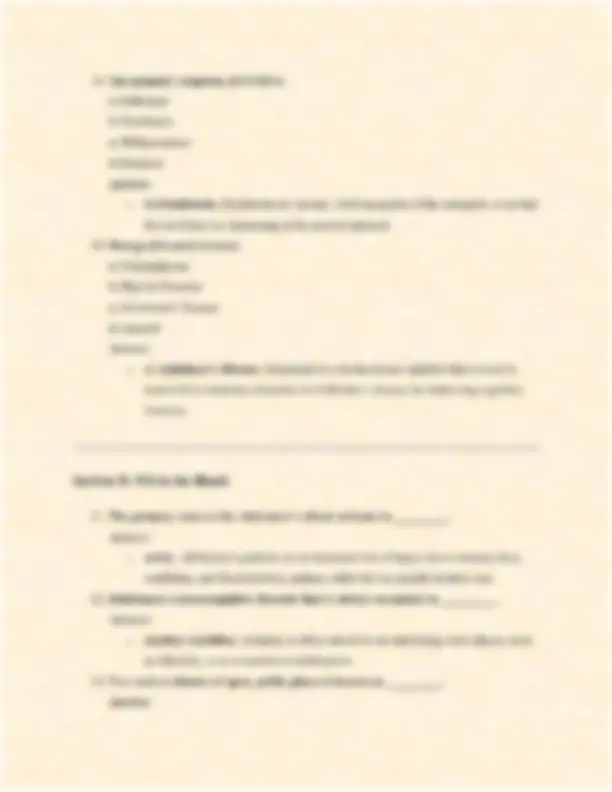Partial preview of the text
Download Prn 1562 mental health exam 2 Questions and verified Answers and more Exams Sociology of Health and Illness in PDF only on Docsity!
PRN 1562 Mental Health Exam 2 (100 OUT OF 100) Questions and Verified Answers (Latest Update) Rasmussen Mental Ilealth Nursing Exam Section A: Short Answer Questions 1. What interventions should be taken when a client is at risk for suicide? Answer: o Remove potentially dangerous items such as shoestrings, curtain rods, and glass items. o Provide the client with plastic utensils to reduce the risk of self-harm. N What are the signs of a bipolar manic episode? Answer: o Engaging in risky behavior, such as spending sprees or reckless driving. o Exhibiting unusually high self-esteem or grandiosity, where the individual may have inflated self-worth or unrealistic beliefs about their abilities. 3. What is the best therapeutic communication strategy when a client is manic? Answer: o Communication should be calm but firm to avoid escalating the situation. o Consistency is key, with short and clear explanations to avoid overwhelming the client. o Redirecting the client’s energy into safe, structured activities while setting clear expectations and consequences can help manage the manic behavior. 4. What is the purpose of the Mini Mental Status Exam (MMSE)? Answer: wn o The MMSE is used to assess cognitive function in clients, particularly to screen for dementia. It involves tasks such as word recall, following instructions like drawing a clock face, and answering orientation questions to evaluate memory, attention, and language skills. Which clients are at higher risk for suicide? Answer: o Clients with a family history of suicide or those who have experienced abuse are at a significantly higher risk of suicide. Such individuals often struggle with deep emotional pain, which increases their vulnerability. What is Compassion Fatigue (Secondary Traumatic Stress) and how does it affect healthcare workers? Answer: o Compassion fatigue is the emotional strain experienced by healthcare workers who are repeatedly exposed to the trauma of others. This can lead to feelings of hopelessness, a deercasc in job satisfaction, and cmotional detachment from patients, potentially impacting the quality of care provided. When are restraints used in a clinical setting? Answer: o Restraints are used when a patient poses a danger to themselves or others, or when the patient is interfering with essential medical therapies. Restraints should always be the last resort after less restrictive interventions have failed. What are the signs of anxiety? Answer: o Signs of anxiety include a sense of impending doom, chest tightness, and an increase in blood pressure. These symptoms reflect the body's heightened state of alertness in response to perceived threats. What is Lamictal (lamotrigine) used for, and what is a serious side effect? Answer: o Lamictal is used to treat bipolar disorder by stabilizmg mood swings. A serious side effect is Stevens-Johnson syndrome, a rare but potentially life-threatening tash that requires immediate medical attention. o True. Valproic Acid, used as a mood stabilizer and anticonvulsant, can cause liver damage, so regular monitoring of liver cnzymes is crucial. Section C: Multiple Choice 16. Le 18. Which of the following is a side effect of Tricyclic Antidepressants (TCAs)? a) Diarrhea b) Tachycardia c) Hypotension d) Weight loss Answer: ob) Tachycardia. TCAs can cause a variety of side effects, including tachycardia (rapid heart rate), due to their anticholinergic properties. Which of the following is a sign of lithium toxicity? a) Increased appetite b) Vomiting c) Fatigue d) Rash Answer: co b) Vomiting. Signs of lithium toxicity include gastrointestinal distress, such as vomiting, as well as more severe symptoms like tremors and confusion. Agnosia, often seen in dementia, is defined as the inability to: a) Remember names b) Recognize objects c) Perform learned tasks d) Understand language Answer: ob) Recognize objects. Agnosia is the loss of the ability to recognize objects, people, sounds, or smells while the specific sense is not defective, nor is there any significant memory loss. 19. The primary symptom of PTSD is: a) Delusions b) Flashbacks c) Hallucinations d) Paranoia Answer: ob) Flashbacks. Flashbacks are intense, vivid memories of the traumatic event that fecl as if they arc happening in the present moment. 20. Donepezil is used to treat: a) Schizophrenia b) Bipolar Disorder c) Alzheimer's Disease d) Anxiety Answer: o ¢) Alzheimer's Disease. Doncpezil is a cholinesterase inhibitor that is used to treat mild to moderate dementia in Alzheimer’s disease by improving cognitive function. Section D: Fill in the Blank 21. The primary concern for Alzheimer’s clients at home is a Answer: o safety. Alzheimer’s patients are at increased risk of injury due to memory loss, confusion, and disorientation, making safety the top priority in their care. 22. Delirium is a neurocognitive disorder that is always secondary to 5 Answer: o another condition. Delirium is ofien caused by an underlymg acute illness, such as infection, or as a reaction to medications. 23. Fear and avoidance of open, public places is known as Answer: o Use calm but firm communication to establish authority without escalating the client’s agitation. o Be consistent in interactions, providing clear and concise explanations to avoid confusion and reduce overstimulation. o Set clear expectations and consequences for behavior, reinforcing boundarics in a respectful but authoritative manner. o Redirect the client’s energy into safe, productive tasks to help manage their manic symptoms effectively. Case Study 2: An 80-year-old client with a history of Alzheimer’s disease is brought to the emergency room by family 













